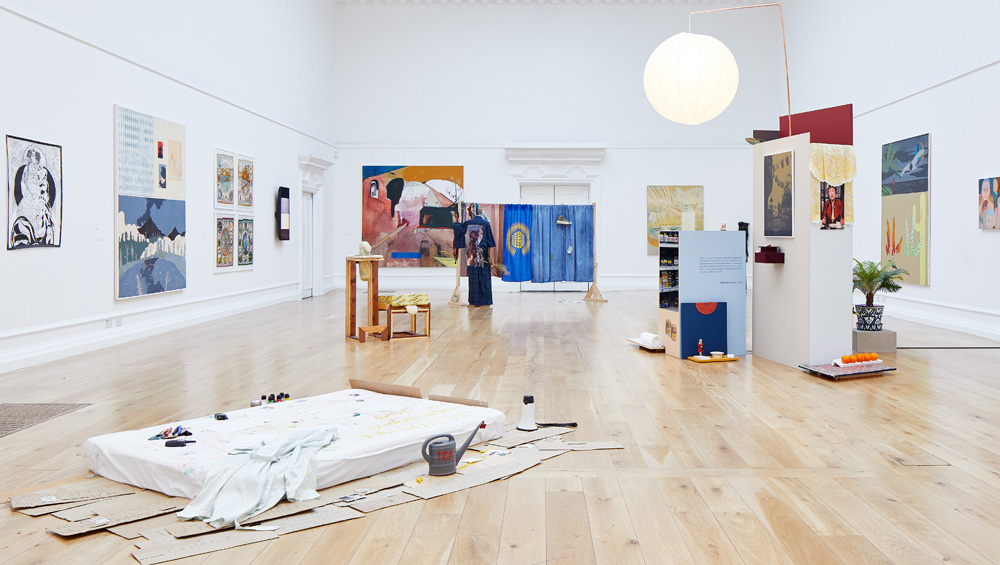
Installation view: Bloomberg New Contemporaries, South London Gallery, 2018. Photo: Andy Stagg.
South London Gallery
5 December 2018 – 24 February 2019
by ROSANNA MCLAUGHLIN
Since it began in 1949, the open submission exhibition Bloomberg New Contemporaries (formerly Young Contemporaries) has been transporting recent and current art school graduates to a professional stage, often for the first time. Degree shows can be ungainly affairs, with artists and artworks forced to compete for space and attention, like contestants in a Darwinian nightmare. For those lucky enough to make the cut, Bloomberg New Contemporaries offers a moment in the sun. Visiting has long been a way to gauge the interests of the next generation of artists, keep track of who is coming through the ranks – and play spot-the-influence. (For 2018, echoes of Rose Wylie, Monster Chetwynd and Tracey Emin resound.) It also provides visitors with a special kind of viewing experience: an opportunity to see art in a context where potential is more valuable than slick, finished products.
The crop of 57 artists for 2018 has been selected by installation artist Benedict Drew and two New Contemporaries alumni: Keith Piper, founding member of the influential BLK Art Group, and the painter Katy Moran. After opening at Liverpool School of Art & Design, Liverpool John Moores University, the exhibition has travelled to South London Gallery, where I caught it. In no particular order, here are my picks of who to watch out for:…
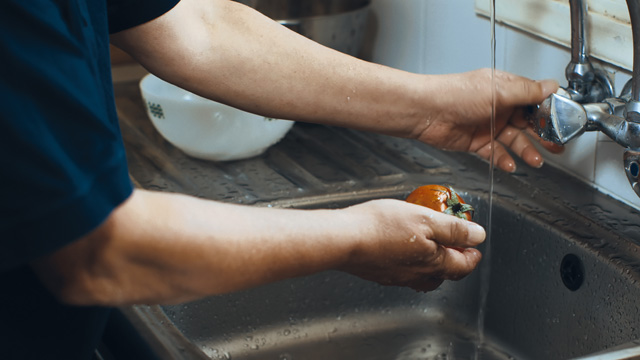
Bella Riza. Salt House, 2017. Video with audio, 12 min 39 sec (film still). © the artist.
Bella Riza
Bella Riza graduated from the Royal College of Art in 2017, and her beautiful short film Salt House (2017) is on view in the newly converted Fire Station, just across from South London Gallery’s main building on Peckham Road. Salt House is a tender record of the artist’s father, Alper, who has returned to his native Cyprus. Alper tells the story of his parents, who married across the fierce divide that separates the island’s Greek and Turkish residents. (“By the time I found out he was Turkish, it was too late,” he recalls his mother saying.) Riza gives her subject time and space, using long, slow camera shots, in which Alper is shown cooking, sleeping, driving and visiting a family plot at a cemetery. The result is a human portrait of love in times of division, and a father-daughter relationship.
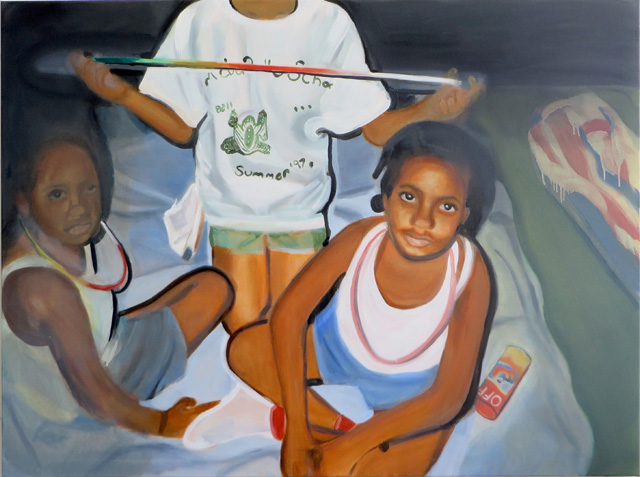
Madelynn Mae Green. Summer ’97, 2018. Oil on canvas, 76 x 101 cm. Acquired by the Government Art Collection from New Contemporaries. © the artist.
Madelynn Mae Green
One of the stand-out stars of this year’s cohort is Madelynn Mae Green, a painter from Milwaukee currently studying on the MA programme at Central Saint Martins. Summer ’97 (2018) is on show in South London Gallery’s main building: an oil on canvas painting of three kids on a bed, each with what looks like a glow stick in their hand or around their neck. Green has painted the figures as if illuminated by the flash of a camera, and the canvas is suffused with dark shadows and moments of overexposure. Like many of her paintings, Summer ’97 has the feel of a snapshot from a childhood photo album that has been upscaled: a picture taken at a birthday sleepover, perhaps, or the bedroom after-party of a first pop concert. Childhood, nostalgia, the mediation of memory by technology – and the historical deficit of portraits of brown subjects – are all folded into Green’s paint.
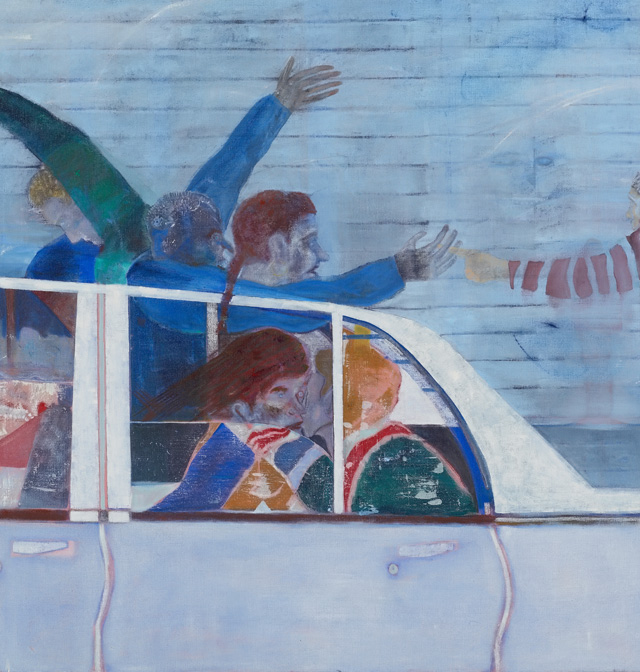
Patrick H Jones. Midday, 2017. Oil on canvas, 150 x 155 cm. © the artist.
Patrick H Jones
Along the wall from Summer ’97 is Patrick H Jones’s oil painting Midday (2017), a large canvas suffused in blues and greens that depicts a car passing through a busy street. On the back seats of the vehicle two figures engage in a charged embrace and, on the street behind, men and women wave their arms in the air. The scene has the feel of reckless abandon and wild speed: limbs flail, faces contort into eerie and violent expressions, and it is not at all clear whether the characters are about to snog or brawl. Jones’s style contains echoes of the early work of New Contemporaries’ alumnus David Hockney, adding to Hockney’s exuberant palette, illustrative style, and general air of psychedelia, his own sharp, psychological edge.
2018 This is the first year that artists attending non-accredited programmes have been eligible for entry to Bloomberg New Contemporaries, and Midday alone is evidence it was the right move. Jones attends Turps art school, a non-accredited painting course established and run by Turps Banana magazine. Without the change in rules, one of the strongest works on show could not have been selected.
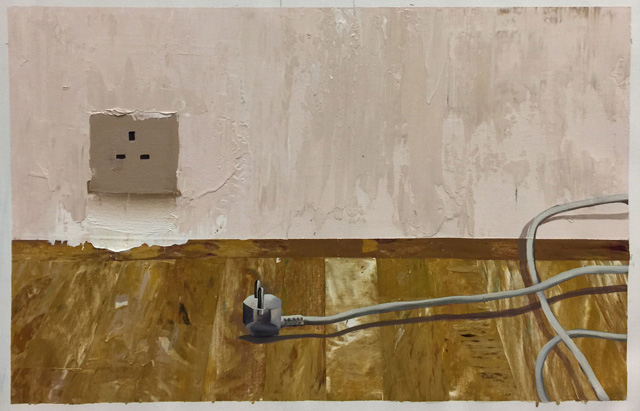
Mohammed Sami. Displacement, 2017. Acquired by the Government Art Collection from New Contemporaries. © the artist.
Mohammed Sami
On show in the Fire Station is Displacement (2017), a small acrylic on linen painting by Mohammed Sami, in which a two-pin plug lies on a wooden floor beside a three-pin socket. Along with Mae Green’s painting Summer ’97, Displacement was bought by the UK’s Government Art Collection, and it is easy to see why: the painting is a remarkably evocative depiction of alienation using the simplest of means. Sami was born in Baghdad, where he studied at the Institute of Fine Art in 2005 before moving to Europe in 2007, where he completed an MA at Goldsmiths in 2018. He has described how the “traumatic aftershocks of the Iraq wars continue to surface as subconscious echoes” in his work. Here, the misaligned plug and socket capture the everyday frustrations of being, as the title suggests, displaced.
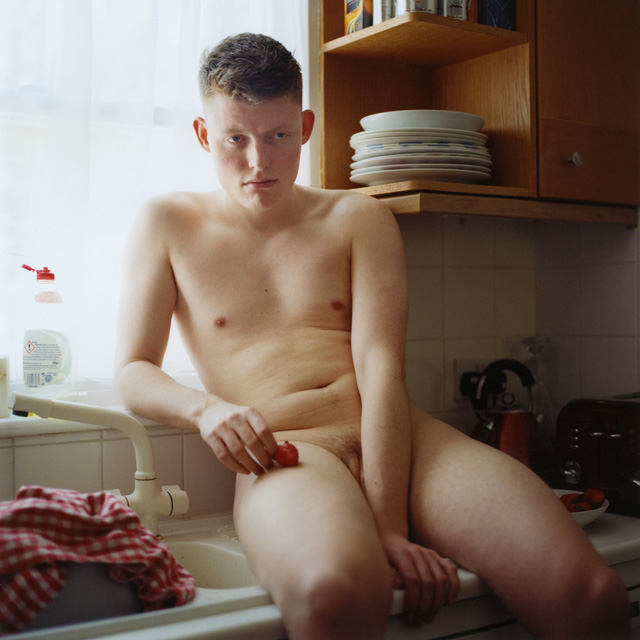
Yushi Li. My Tinder Boys–Edric, 24, 13 km away, 2017. C-type print 94 x 94 cm. © the artist.
Yushi Li
A PHD student at the Royal College of Art, Yushi Li shows a photograph from her series My Tinder Boys: portraits of naked, young, white men cooking and eating in kitchens. The picture on display in South London Gallery’s main building is of a sulky-looking looking youth with pink lips, sitting on a draining board. With one hand, he absent-mindedly rubs a strawberry against his thigh; the other hand is pressed against the counter top between his legs, partially covering his penis with his arm in the process. He looks sweet, vulnerable, decorative, and also angelically clean – the latter a surprising quality of a depiction of a Tinder hookup that is enhanced by the pale, milky light Li has achieved. The impact is arresting, and is a reminder of how rare it still is to apprehend the erotic female gaze in a gallery setting.